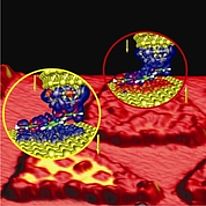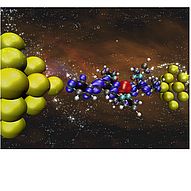
Molecular Electronics
When the field Molecular Electronics was emerging at the end of the last century, its main drive was towards building new devices for applications in information and sensor technology. This still is important motivation driving the field.
However, it soon became clear that Molecular Electronics is much more than this. It is a field of fundamental sciences, where Chemistry, Surface and Condensed Matter experts collaborate in order to understand fundamental processes at interfaces in and out of equilibrium. Questions range from the flow of charge and heat around single atoms in molecular switches up to biological scales, where sticking of specific viruses can be gate-controlled on certain semi-conductor surfaces; see our recent Review of Modern Physics.
Enormous challenges exist in the field concerning method development but also with respect to analyzing fascinating experiments on single molecule or even single atom transport. Activities in our group concern both directions, supported by numerous international collaborations.
Molecular Instabilities and Magnetism
A very distinct feature of molecules, that makes them very special as compared to, e.g., quantum dots familiar from semi-conductor devices, originates from their symmetries, e.g. related to space groups. Roughly speaking, such symmetries can produce degeneracies which in turn lead to the competition of ground states, say magnetic vs. non-magnetic ones. As a consequence, by proper chemical design a molecular structure can be tuned close to an instability which then can be addressed experimentally, say by a gate voltage or strain. In this way, a molecular bistability can be constructed, that can exhibit, e.g., a switchable Kondo-effect.
Read more on a switchable Kondo effect in our Physical Review Letters article.
 In close collaboration with experimental groups, we study such molecular switches theoretically with methods comprising the density functional theory (DFT) and non-equilibrium Green's functions. In addition, also more advanced electronic structure machinery, like the GW-method, is being used.
In close collaboration with experimental groups, we study such molecular switches theoretically with methods comprising the density functional theory (DFT) and non-equilibrium Green's functions. In addition, also more advanced electronic structure machinery, like the GW-method, is being used.
Read more about a giant magnetoresistance across a single molecule in our Nature Nanotechnology

